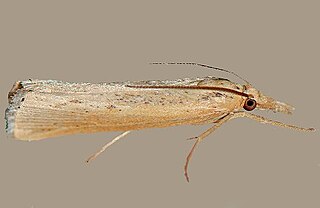
Crambidae comprises the grass moth family of lepidopterans. They are variable in appearance, with the nominal subfamily Crambinae taking up closely folded postures on grass stems where they are inconspicuous, while other subfamilies include brightly coloured and patterned insects that rest in wing-spread attitudes.
Anatralata is a genus of moths of the family Crambidae. It contains only one species, Anatralata versicolor, which is found in North America, where it has been recorded from California to Idaho and British Columbia. The habitat consists of mountainous areas and low-elevation grasslands along the coast of central California.
Arequipa is a genus of moths of the family Crambidae. It contains only one species, Arequipa turbatella, which is found in North America, where it has been recorded from Alabama, Illinois, Maine, Maryland, North Carolina, Ohio, Ontario, Pennsylvania, Quebec and West Virginia.
Mojaviodes is a genus of moths of the family Crambidae. It contains only one species, Mojaviodes blanchardae, which is found in North America, where it has been recorded from Texas.
Nannobotys is a genus of moths of the family Crambidae. It contains only one species, Nannobotys commortalis, which is found in North America, where it has been recorded from eastern Washington to California and Nevada.
Neocataclysta is a genus of moths of the family Crambidae. It contains only one species, Neocataclysta magnificalis, the scrollwork pyralid moth, which is found in North America, where it has been recorded from Florida, Georgia, Maine, Massachusetts, Mississippi, New Jersey, New York, North Carolina, Nova Scotia, Ohio, Ontario and South Carolina.
Neocymbopteryx is a genus of moths of the family Crambidae. It contains only one species, Neocymbopteryx heitzmani, which is found in North America, where it has been recorded from Arkansas.
Odontivalvia is a genus of moths of the family Crambidae. It contains only one species, Odontivalvia radialis, which is found in North America, where it has been recorded from Texas.

Pseudoschinia is a genus of moths of the family Crambidae. It contains only one species, Pseudoschinia elautalis, which is found in North America, where it has been recorded from Arizona, California, Nevada, New Mexico and Texas.
Paregesta is a genus of moths of the family Crambidae. It contains only one species, Paregesta californiensis, which is found in North America, where it has been recorded from California.

Perispasta is a genus of moths of the family Crambidae. It contains only one species, Perispasta caeculalis, or Titian Peale's pyralid moth, which is found in North America, where it has been recorded from Quebec west to British Columbia, south to Florida, Texas and Colorado. The habitat consists of fields and meadows. Both the genus and species were first described by Philipp Christoph Zeller in 1875.
Plumipalpiella is a genus of moths of the family Crambidae. It contains only one species, Plumipalpiella martini, which is found in North America, where it has been recorded from California.
Raphiptera is a genus of moths of the family Crambidae. It contains only one species, Raphiptera argillaceellus, the diminutive grass-veneer, which is found in eastern North America, where it has been recorded from Labrador, Ontario, Wisconsin, Connecticut, New York, Quebec, Alberta and Michigan. The range extends to Florida and Texas in the south-east and Costa Rica in Central America. The habitat consists of bogs.

Tehama is a genus of moths of the family Crambidae. It contains only one species, Tehama bonifatella, the western lawn moth, which is found in Greenland and North America, where it has been recorded from Alberta, British Columbia, California, Colorado, Labrador, Manitoba, Nevada, Quebec and Washington. The habitat consists of grasslands.

Dioryctria albovittella, the pinyon tip moth, is a species of moth of the family Pyralidae. It is found in North America including New Mexico.

Dioryctria ebeli, the south coastal coneworm moth, is a species of moth of the family Pyralidae. It is found in the US states of Florida, the southern parts of South Carolina, Georgia, Alabama, Massachusetts, and south-eastern Louisiana.

Dioryctria amatella, the southern pineconeworm moth, is a species of moth of the family Pyralidae. It is found in the south-eastern United States, from Maryland south to Florida and west into Texas.

Dioryctria disclusa, the webbing coneworm or rusty pine cone moth, is a species of moth of the family Pyralidae. It is found in North America from New Brunswick to Florida, west to Texas and north to Manitoba.
Argyractis drumalis is a moth in the family Crambidae. It is found in North America, where it has been recorded from Florida.

Argyria rufisignella, the mother-of-pearl moth, is a moth in the family Crambidae. It was described by Philipp Christoph Zeller in 1872. It is found in North America, where it has been recorded from the eastern United States and in the south to Arizona.










